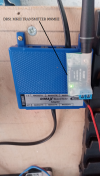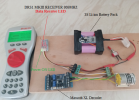Hello Scott, everybody...
Right, firstly, back to the very beginning..
Secondly, a look at the Rx6n receiver specifications, and what the pins actually do/are..
Thirdly, a blow-by-blow through the above post. where it is incorrect, and tie everything together.
Act One:
Scott states he has Mogul, wants to go battery RC etc.
Over the first dozen posts in this thread, we learn he wants to keep lighting (including firebox). That the loco has an early MTS card, and there is a generic steam sound unit ( a 65001) in the tender.
Post #2 scott has a Deltang vendor offering a way of doing things.. Several others chip-in with what they did, how battery DCC may-may-not be an easy install (it is, IF you want DCC, if you have the knowledge, and IF you do not need to alter anything via CV's).
But basically, by post #12, all the information is there to make an 'easy' transition to battery RC (granted, without sound at this point) and with a bit of reading and fore-thought, a working system. - No smoke.
We have learnt Scott has a deltang-derived Tx22 transmitter/controller, and access to Deltang Rx65c and Rx66a receivers/ESC's.
He also has a 4S Lithium-based battery-pack.
Act Two:
The Deltang Rx65c receiver/ESC is specified to work between 3-13V. So 3-8 NiMH cells, or 1-3 Lithium cells, etc. -
A 4S battery exceeds this.
The fact it worked at all, is very lucky.. Either the batteries were below full-charge, or it was just luck that the particular Rx65c did not immediately self-oscillate, and destroy itself.
The motor outputs are a PWM signal, where 'full battery voltage' is switched off and on very rapidly.. If the 'on' part of the cycle is a lot smaller than the 'off', then the motor will rotate slowly.. If the 'on' part of the cycle is larger than the 'off' then the motor will rotate faster. - Please note, this is the 'lies to children' version. In reality, it gets a lot more complex than this, but we do not need to know that here.
Aside:
This off/on 'full-voltage' will have confused the hell out of the LGB 65001 sound module. - More on this later.
The 'A', 'B', and 'C' outputs on the Rx65c are 'reinforced outputs'. - Basically a transistor switch, which is either open (when off) or a connection to 'ground (0V) when on. Supposedly, capable of sinking 2 Amps each, but this all goes throught the tracks on the PCB, and the device is rated for a TOTAL CURRENT of 3 Amps. - That is for everything, motor, lights, driving the receiver..
The 'L' pin is an input for monitoring the voltage of a single Lithium cell, when a step-up device is used to increase the voltage to the receiver, but a single-cell is used because of space limitations.
The other output pins, are 'logic-level' outputs/inputs, from/to the chip on the PCB. They can theoretically sink 12mA per pin, so will drive a LED (or two with care) or can be used to provide a trigger to an external device. - Say, a soundcard.
They switch between 3.3V and 0V. - Which is the internal supply voltage of the processor etc. on the board. This 3.3V regulated supply is provided by a teeny-tiny 2mm square regulator chip, so it is self-evident, you can't pull lot's of current from these pins!
These 'logic-level' pins can drive LED's with a suitable resistor. - But watch your total-current draw!
All these pins can have their configuration altered by programming. Some of the defaults (as examples) are:
Pad 'A' Front Light (auto action) 0V when 'on', disconnected when 'off'. - So, as this is a 'reinforced output' you could drive a suitable voltage (battery supply) bulb for a front light. It would be wired between Pad 'A' and battery positive.
Pin 1 Front Light (auto action) 3.3V when 'on', 0V when 'off'. - So you could drive a LED directly from this output (with a series resistor). It would be wired from Pin 1, through a resistor, to the LED, and then then other leg of the LED would connect to 0V.
Pad 'C' On/Off Momentary action, Channel 5 (the Bind button). - Gives 0V when the button is pressed, so could be used to sound a whistle/horn by triggering a soundcard.
NOTE: NOT the 65001 soundcard!
Act Three:
I finally decided to remove the LGB MTS card from my loco and the hardware required to transfer track power to the loco motor
Decision made: remove MTS, so you are going to have to wire lights etc. yourself, work-out how to get them directional etc.
Next I rewired the loco and tender for radio control (DelTang Tx22 transmitter with Rx65c or Rx66receivers) and battery power (4s Li ion battery from RLD Hobbies).
The 4S battery exceeds the specification of the Rx65c. Theoretically, it should be OK with a Rx66a, but I would not personally do it. - Both these receivers can be obtained from certain suppliers with a replacement regulator. We guarantee the installation to 18V with this modification.
I found that the pads A, B, and C of the receivers actually yield 3.3 v and the negative leads of the headlight LEDs should be soldered to them. The positive leads should be connected to either the L pad or the positive terminal of the high current Rx65 adaptor.
This is not correct! - See Act Two, above, for the correct information on the Pad 'A' to 'C' output specifications.
This is not the correct usage of the 'L' Pad.
To use LED's with these pads, you would wire the LED's between the pads and Battery Positive. - You would need to calculate suitable series resistor values for your LED characteristics, using your battery-voltage.
I used a 47 or 75 ohm resistor in line with the LEDs to reduce the brightness to the desired level.
I would recommend you increase the value of the resistors to 150 ohms.
I like your approach to the Firebox LED's.. - Did you make it so you can turn this off/on from your transmitter?
I thought that since the 65001 in analog mode was originally connected to track power I could simply connect the same leads to the motor leads from the Rx65 or the Rx66. Bad idea. Train ran for a few seconds, sound blaring.
Remember what i said about the motor output? - You were putting pulses of full-battery-voltage into the 65001. This was thinking the loco was running very fast, and was also probably trying to work-out if there was a MTS data signal amongst all these pulses.
You have discovered the Buhler motors are pretty efficient, and will start turning with2-3 Volts. The MTS circuits require a good 5-6 Volts before they are 'happy' and start to join the party.
This is why many analogue LGB loco's will start moving well-before the sounds will start. - Some have an on-board battery, which will keep sounds going whilst an analogue loco is stationary. This battery can be charged from the track, but does require the loco to be run at quite a speed, for there to be enough voltage for this.
When the 65001 is fed from an analogue controller, it receives a smooth, constant voltage. This increases the faster the loco is made to run, so the unit can interpret this information and give a variable 'chuff' to match.
When the 65001 is fed a PWM signal, it gets (lots!) of pulses of full-voltage (value is roughly your battery-voltage). The card thinks these big pulses mean 'very-fast', and tries to keep-up.
You can use an 'opto-isolator' to convert the pulses to a smoothly increasing voltage, or you can fit a special filter circuit which will do the same thing. Unfortunately, whichever of these you choose, there will be some delay before the sound starts, as the 65001 needs 5-6 Volts before it will operate correctly.
If the unit had the necessary parts, then an external 'chuff-trigger' could be used to drive the 65001 to correctly chuff to the wheel rotation. Unless the sound unit had extra wires down to the wheels (other than for power-pickup) I doubt it is equipped to do this, sorry.
Now the Rx65c has been replaced with an Rx65c adapted for higher current. It works fine without the 65001 (I'm afraid to try it with the sound module installed).
This module will be quite power-hungry, so this is a wise decision. - It 'could' be fed through a suitable isolation device, but this would require a certain level of knowledge to do safely.
A slight correction/query: You say the replacement Rx65c is "adapted for higher current"? - You would only be able to pull more current by using an external ESC.. I believe you probably have a Rx65c with a little extra board on it (not a big one covering the whole receiver)? If I am correct, then this is an alternative regulator, allowing the Rx65c to work with a higher battery supply voltage.
It may be your supplier still had the older Rx65b available? - In which case there would be a second board, as big as the original receiver, This board would increase the current capacity of your system.
The older (now no longer available) Rx65b was good to approximately 18V, as supplied.
Scott,
This has not been meant a s a dig at you, but an explanation of what went wrong.
Hopefully, it is of use, and may help other who stumble across it in the future?
Enjoy your trains!
Phil Partridge.
phil@rctrains.co.uk

